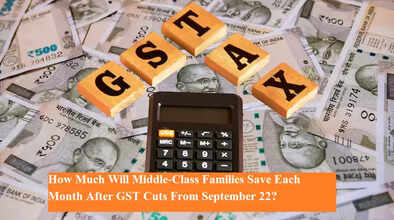How Much Will Middle-Class Families Save Each Month After GST Cuts From September 22?

Consumer Relief Update: Starting September 22, 2025, households across India, especially middle-class families, are set to experience a noticeable reduction in their monthly expenses. The GST Council has approved a major restructuring of the Goods and Services Tax system by merging the existing four slabs into just two. This change means thousands of products and services will become cheaper, offering relief to families struggling with rising inflation.
Why the GST Cut Matters for the Middle Class
For years, India’s middle class has been squeezed between stagnant incomes and rising living costs. Experts point out that the new GST rates will directly ease household budgets by reducing the tax burden on everyday essentials as well as key financial services.
Take the example of a middle-class family in Delhi with a monthly income of around ₹50,000–₹60,000 and two children. If this family lives in a rented house, a large share of its monthly income is spent on food, groceries, clothing, healthcare, and education. With GST rates coming down on many of these items, the family will now see significant monthly savings, leaving them with more disposable income.
Kitchen Budget to Shrink
The biggest relief will be in the kitchen. Items such as paneer, ghee, and namkeen, which earlier attracted 12% GST, will now fall into the 5% slab.
-
Suppose a household spends ₹5,000 a month on these essentials.
-
Under the old system, they paid ₹500 as tax.
-
After the reduction, they will only pay ₹250, saving ₹250 every month.
Similarly, clothing priced up to ₹2,500 will now attract just 5% GST instead of 12%. A purchase of ₹2,500 in apparel earlier included ₹240 tax, which will now drop to ₹100.
Everyday Products Get Cheaper
Personal care and healthcare expenses will also see a positive impact. Until now, items like shampoo, toothpaste, and hair oil carried 18% GST. From September 22, these products will also fall under the 5% category.
-
If a family spends ₹1,500 a month on these items, they currently pay ₹270 in tax.
-
After the revision, they will pay just ₹75, saving nearly ₹200 every month.
Medicines, another major household expense, will also see a tax cut, making them more affordable for middle-class families and senior citizens.
Savings on Insurance Premiums
Perhaps one of the biggest reforms is the removal of GST on insurance premiums. Earlier, both life insurance and health insurance policies attracted 18% GST.
For instance:
-
A family paying ₹2,000 per month for health insurance previously paid ₹360 extra as tax.
-
With GST reduced to zero, they will now save that entire amount, directly lowering their overall monthly spending.
This move is expected to encourage more households to opt for insurance coverage while also rewarding existing policyholders with immediate savings.
How Much Can a Family Actually Save?
When all categories—groceries, personal care, clothing, medicines, and insurance—are combined, experts estimate that a typical middle-class family could save anywhere between ₹1,000 to ₹2,000 per month depending on their spending patterns.
While this may seem modest, over the course of a year, these savings could add up to ₹12,000–₹24,000, offering much-needed breathing space in household budgets.
Final Word
The GST reforms taking effect on September 22 are more than just a tax adjustment—they are a direct attempt to provide relief to middle-class families battling inflation. From cheaper kitchen supplies to reduced personal care costs and zero tax on insurance premiums, the changes will free up a portion of household income for other essential needs or savings.
For India’s middle class, this reform represents not only lower monthly expenses but also a step toward greater financial comfort in the months to come.

